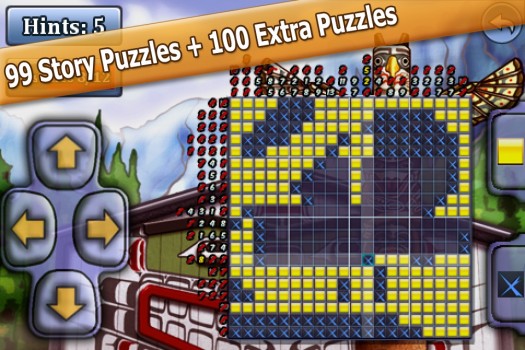![]() Every logic puzzle lover should know about nonograms. You might know them as picross puzzles, or griddlers, or maybe just the younger sibling of Sudoku, but you should know them. If you don’t, no foul: Fugazo’s World Mosaics [$1.99] is a good place to start.
Every logic puzzle lover should know about nonograms. You might know them as picross puzzles, or griddlers, or maybe just the younger sibling of Sudoku, but you should know them. If you don’t, no foul: Fugazo’s World Mosaics [$1.99] is a good place to start.
If you’re not in the know, here’s the quick version: a nonogram puzzle presents you with a grid. Each row and column has numbers listed with it, and those numbers correspond to how many of its cells must be filled in. A row with 5 and 7 listed beside it would need 5 adjoining cells filled in with boxes, then at least one space before 7 more cells are boxed in. The clues intersect so you can puzzle out the solution, and when you’re done you’ll have formed a pixelated picture.
There are some great nonogram apps on iOS already, though fewer than I’d like. World Mosaics joins these after enjoying a successful career on PC and Mac. It’s not perfect, but it scratches the logic puzzle itch nicely.
World Mosaics takes roughly half its list of puzzles, the first 99, and wraps them in a globe-spanning story. You follow pictographic clues left around the world to discover the origins of the Sea People. I’d point out that logic puzzles need stories like fish need bicycles here, but the story does give Fugazo a chance to wrap the puzzles in entertaining themes. I could also stretch and say that it offers a reason to keep pushing to the end of the game, but I suspect it’s more likely there to bring in fans of hidden object games and match-3 adventures.
But these casual trappings don’t detract from the quality of the puzzles. The nonograms in World Mosaics are good, challenging and varied. Beginners will find the difficulty curve just perfect — a few introductory 5 x 5 puzzles make way for 10 x 10, 15 x 15 and eventually 20 x 20 grids. Each jump increases the difficulty, but it’s a slow climb. A wide range of challenges are available within those sets, too, with some puzzles that have plenty of large numbers and clearly defined borders, and others that scatter ones and twos to the wind and leave you to pick your way through cell by cell.
Control is a huge problem with nonogram apps on small devices, and it’s one that’s not fully addressed here. There simply isn’t enough screen real estate to tap around a 15 x 15 grid. Fugazo has included an awkward set of on-screen controls, with a direction pad for navigation and buttons to mark boxes and cross out spaces. Since these controls offer no feedback, it’s all too easy to mis-mark a cell.
Mistakes will cost you, but failure isn’t a real threat. You can make up to 8 mistakes per puzzle, and each gives a handful of hints if you need them. This is where World Mosaics goes most seriously awry. The game tracks your mistakes, hints and completion time, but it doesn’t seem to maintain that information anywhere. Without Game Center integration or any kind of tracking or ranking, there’s nothing to keep you from using each of your freebies to brute force your way through tough spots. Best put yourself on the honor system, because it’s much more fun to play properly.
World Mosaics could also be better in the looks department. The game isn’t ugly, exactly, but it’s not a looker either. Retina graphics are badly missed. They’d make the game’s large puzzles much easier to look at. On top of that, the interface is utilitarian at best. Put these things together with the lack of Game Center and World Mosaics starts to feel like a bit of a shoddy port.
It’s not a shoddy game, though. Along with those 99 story puzzles, World Mosaics offers another hundred or so that don’t fit with the story’s themes. That’s a lot of hours of entertainment to be had. If you have an iPad, I’d recommend waiting for the HD version, which is due to hit in mid-November. Nonograms are more fun when you have more space to work with. But for those of us who want good nonograms on the small screen, World Mosaics is an ample fit. Make sure to stop by our discussion thread and let us know what you think.
